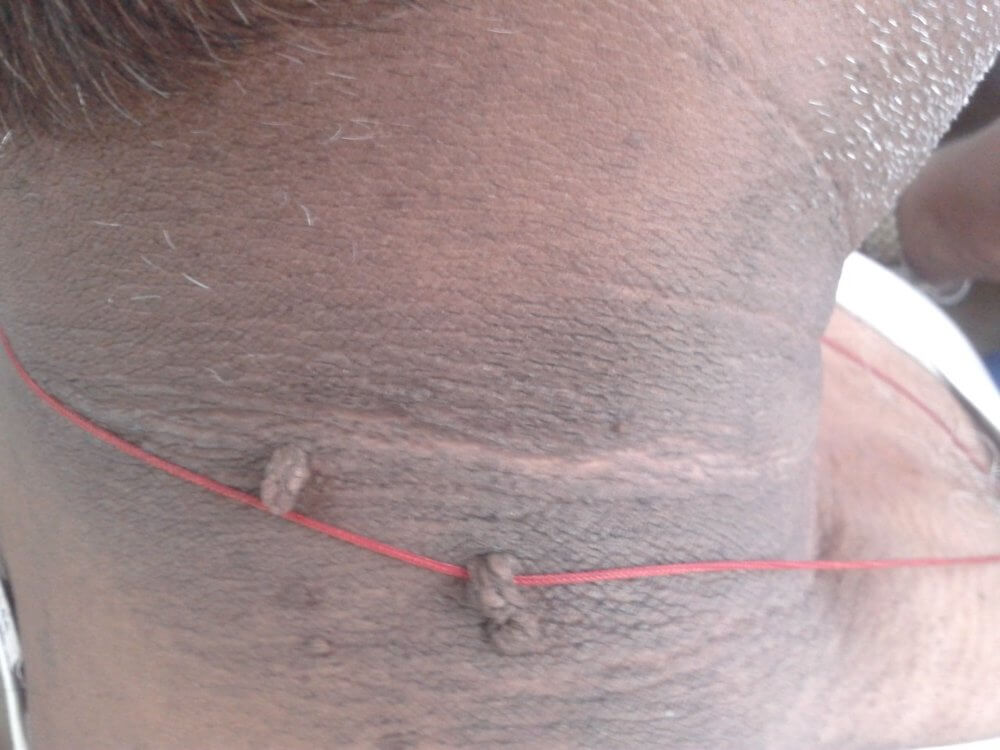What is acanthosis nigricans?
Acanthosis nigricans is a fairly common skin pigmentation disorder. The most notable sign of acanthosis nigricans is dark patches of skin with a thick, velvety texture. The affected areas of skin may also itch or have an odor.
These patches may appear on skin folds and other areas, such as the:
- Armpits
- Groin
- Neck
- Elbows
- Knees
- Knuckles
- Lips
- Palms
- Soles of the feet
Acanthosis nigricans may be a sign of a more serious health problem, such as prediabetes. The most effective treatments focus on finding and resolving medical conditions at the root of the problem. These skin patches tend to disappear after successfully treating the root cause of the state.
Who is at risk for acanthosis nigricans?
Acanthosis nigricans is seen in both men and women. It’s most common in those who are overweight, have darker skin, and have diabetes or prediabetic conditions. Children who develop acanthosis nigricans are at a higher risk of developing type 2 diabetes later in life.
The frequency of acanthosis nigricans varies between ethnic groups. According to the American Academy of Dermatology, people of African, Caribbean, or Hispanic descent are also at an increased risk. All ethnic groups are equally at risk of acanthosis nigricans when body mass index (BMI) is above standard.
What causes acanthosis nigricans?
Acanthosis nigricans skin patches occur when epidermal skin cells begin to reproduce rapidly. This abnormal skin cell growth is most commonly triggered by high levels of insulin in the blood. In rare cases, the increase in skin cells may be caused by medications, cancer, or other medical conditions.
Too much insulin
The most frequent trigger for acanthosis nigricans is too much insulin in your bloodstream.
When you eat, your body converts carbohydrates into sugar molecules such as glucose. Some of this glucose is used for energy in your cells while the rest is stored. The hormone insulin must allow glucose to enter cells so that the cells can use glucose for energy.
Overweight people tend to develop resistance to insulin over time. Although the pancreas is making insulin, the body can’t use it properly. This condition creates a buildup of glucose in the bloodstream, which can result in high levels of both blood glucose and insulin in your bloodstream.
Excess insulin causes normal skin cells to reproduce at a rapid rate. For those with dark skin, these new cells have more melanin. This increase in melanin produces a patch of skin that’s darker than the skin surrounding it. Thus, the presence of acanthosis nigricans is a strong predictor of future diabetes. If too much insulin is indeed the cause, it’s relatively easy to correct with proper diet, exercise, and blood sugar control.
Medications
Acanthosis nigricans can also be triggered by certain medications such as birth control pills, human growth hormones, thyroid medications, and even some bodybuilding supplements. All of these medications can cause changes in insulin levels. Medications used to ease the side effects of chemotherapy have also been linked to acanthosis nigricans. In most cases, the condition clears up when the drugs are discontinued.
Other potential causes
In rare cases, acanthosis nigricans can be caused by high doses of niacin, hormonal disturbances, gastric cancer.
How is acanthosis nigricans diagnosed?
Acanthosis nigricans is easy to be recognized by sight. Your doctor may want to check for diabetes or insulin resistance as the cause. These tests may include blood glucose tests or fasting insulin tests. Your doctor may also review your medications to see if they’re a contributing factor.
It’s important to tell your doctor about any dietary supplements, vitamins, or bodybuilding supplements you may be taking in addition to your prescription medications.
In rare cases, your doctor may perform other tests, such as a small skin biopsy, to rule out other possible causes.
How is acanthosis nigricans treated?
Acanthosis nigricans isn’t a disease. It’s a symptom of another condition that may require medical attention. Treatment is focused mainly on addressing the situation that’s causing it. If you’re overweight, your doctor will advise you to lose weight. Your doctor may also prescribe medications to help bring your blood glucose under control.
If medications or supplements cause the condition, your doctor may ask you to discontinue them or suggest substitutes. The discolored skin patches will usually fade when you find the cause, and it is under control.
Cosmetic treatments
If you are concerned with the appearance of your affected skin, there are cosmetic treatments available. Treatments include:
- Skin lighteners, like Retin-A, 20 percent urea, alpha hydroxy acids, and salicylic acid
- Oral acne medications
These treatments can improve the appearance of acanthosis nigricans but will not cure the condition.
Ongoing care and prevention
Maintaining a healthy lifestyle can usually prevent acanthosis nigricans. Losing weight, controlling your diet, and adjusting any medications that are contributing to the condition are all crucial steps. Healthier lifestyle choices will also reduce your risks for many other types of illnesses.



